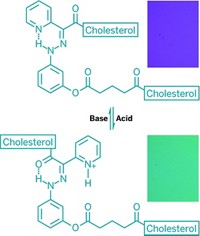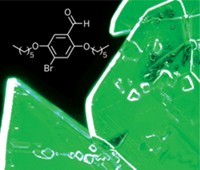Advertisement
Grab your lab coat. Let's get started
Welcome!
Welcome!
Create an account below to get 6 C&EN articles per month, receive newsletters and more - all free.
It seems this is your first time logging in online. Please enter the following information to continue.
As an ACS member you automatically get access to this site. All we need is few more details to create your reading experience.
Not you? Sign in with a different account.
Not you? Sign in with a different account.
ERROR 1
ERROR 1
ERROR 2
ERROR 2
ERROR 2
ERROR 2
ERROR 2
Password and Confirm password must match.
If you have an ACS member number, please enter it here so we can link this account to your membership. (optional)
ERROR 2
ACS values your privacy. By submitting your information, you are gaining access to C&EN and subscribing to our weekly newsletter. We use the information you provide to make your reading experience better, and we will never sell your data to third party members.
Environment
Naked-Eye Sensors Detect Anions
Thiourea-based colorimetric sensors recognize biologically important anions in aqueous solution
by Michael Freemantle
February 13, 2006
| A version of this story appeared in
Volume 84, Issue 7

All chemists are familiar with the litmus test. Like other acid-base indicators, litmus changes color when the pH of a solution changes. The indicator is an example of a "naked-eye" colorimetric ion sensor. In the presence of hydroxonium ions (H3O+), litmus is red, whereas in alkaline solution it is blue.
Chemists at Trinity College Dublin (TCD) have now developed a family of naked-eye colorimetric anion sensors, which, they say, could potentially be used like litmus paper to check domestic water quality and for environmental and other applications.
"Naked-eye colorimetric sensors that detect anions in aqueous solution are few and far between," says Paul E. Kruger, senior lecturer in inorganic chemistry, who developed the sensors with associate professor of chemistry Thorfinnur Gunnlaugsson and coworkers at TCD (J. Org. Chem. 2005, 70, 10875).
Kruger holds up a piece of blue litmus paper. "Easy to use, commonly available litmus-paper-style colorimetric tests for simple anions such as acetate, fluoride, and phosphate should find great utility," he says.
The thiourea-based chemosensors are receptors that act as hosts for guest anions in aqueous solution. They work by forming strong hydrogen bonds with the anions. The receptors are known as charge neutral because they have no overall charge. When the molecules bind to anions, charge is transferred inside the molecules, resulting in a change of light absorption that can be detected by the naked eye and also by ultraviolet-visible spectroscopy.
"We find anions throughout nature," Kruger observes. "They are involved in numerous biological processes. For example, adenosine triphosphate, which plays a key role in cell energetics, is an anion. Anions are also associated with diseases such as cystic fibrosis, which is caused by malfunction of chloride channels. And nitrate anions from fertilizers can cause eutrophication when they leach from agricultural land into water."
In nature, recognition of anions such as acetate, fluoride, and phosphate is primarily achieved by hydrogen bonding at charged or charge-neutral organic receptors. These host-guest interactions are inherently weak and therefore notoriously difficult to mimic in the laboratory because solvent molecules compete more effectively for the receptors than the guest anions.
Over the past four decades, receptors that use electrostatic ion-ion interactions, hydrogen-bond donor groups, Lewis acid groups, and hydrophobic interactions have been used in the laboratory to bind a variety of anionic guest species, observes Philip A. Gale, reader in chemistry at the University of Southampton, in England. "Neutral anion receptors containing hydrogen-bond donors are an important subset of anion-binding agents," he notes (Chem. Commun. 2005, 3773).
However, many of these systems sense anions only in noncompetitive organic solvents. "To the best of my knowledge, there are no anion sensors that operate like ours in competitive pH-buffered aqueous solutions through hydrogen bonding to charge-neutral molecules," Gunnlaugsson tells C&EN. "Buffering is important because anion structures are pH-dependent. At low pH they become protonated, losing their negative charge. We therefore buffer our sensors at pH 7.3, the physiological pH."

Gunnlaugsson, who heads the supramolecular and medicinal chemistry research group at TCD, and Kruger, who leads the inorganic supramolecular chemistry group, teamed up to work on the project four years ago because of their mutual interest in supramolecular chemistry. Gunnlaugsson brought his expertise in spectroscopy and organic synthesis to bear on the project, whereas Kruger's research provided input on structural solid-state chemistry and single-crystal X-ray crystallography. They carried out the work in collaboration with Frederick M. Pfeffer, lecturer in organic chemistry at Deakin University, in Australia.
To prepare their chemosensors, the Dublin chemists start with a naphthalimide and hydrazine monohydrate. When the two compounds react, a yellow solid is formed that reacts with an isothiocyanate to produce the sensor in greater than 90% yield. The sensor is insoluble in water. The chemists therefore prepare aqueous solutions of the sensor by first dissolving it in ethanol. Finally, they prepare a 50:50 water-ethanol solution, using a pH 7.3 buffer consisting of imidazole and hydrobromic acid.
To demonstrate the sensor's naked-eye color change, Haslin Dato Paduka Ali, a Ph.D. student working with Gunnlaugsson and Kruger, spots a filter paper with drops of the yellow sensor solution. She then pipettes a drop of an aqueous solution of tetrabutylammonium acetate onto one of the yellow spots. The color immediately changes to purple. Next, she directs a drop of a dimethyl sulfoxide (DMSO) solution of the acetate onto another spot. An even deeper purple appears.
"The purple is more intense because DMSO is a less competitive solvent," she explains.
Fluoride and phosphate ions in aqueous solutions are readily detected by the thiourea sensor and UV-Vis spectroscopy. However, naked-eye color changes are faint and only barely observable at low concentrations.
"The selectivity is toward three biologically relevant anions-acetate, fluoride, and dihydrogenphosphate-at different concentration ranges," Gunnlaugsson says. "The sensors have highest selectivity for acetate over fluoride, which are both detected preferentially over dihydrogenphosphate. Acetate gives a deep-purple color, even at low concentrations, whereas fluoride and dihydrogenphosphate result in less intense colors or no color change, depending on concentration." Other anions, such as bromide, chloride, perchlorate, and sulfate, give no response.

The discovery represents a big step forward in the development of chemosensors for anions that work in real-world applications and call for sensitivity, selectivity, and naked-eye-detectable response in highly competitive aqueous environments, comments Jonathan L. Sessler, chemistry professor at the University of Texas, Austin. "The elegance of the design and the simplicity of the synthesis also help make such potential uses conceivable," he says.
According to the TCD group, ureas, like thioureas, are known to bind well to certain anions because of the acidic nature of the compounds' NH protons. The Dublin chemists have therefore recently extended their work to urea-based analogs of their colorimetric anion sensors. They showed, in as-yet-unpublished work, that naphthalimide ureas, synthesized from a naphthalimide, hydrazine monohydrate, and an isocyanate, can be used for naked-eye sensing of acetate, dihydrogenphosphate, and fluoride in DMSO solutions. The urea sensors, however, do not detect anions in aqueous solutions.
Like the thiourea sensors, the urea sensors change color from yellow to purple on complexation with any of the three anions. In the case of fluoride complexation, the color of these sensors goes from yellow to purple at low concentrations of fluoride ions, whereas at high concentrations, the change is from yellow to pale orange.
The thiourea and urea sensors should also work for other carboxylates, the Dublin chemists say, although they have yet to test these anions.
"We now plan to modify the sensors' receptors to see if we can detect other anions in water," Kruger says. "Our work on these systems augurs well for their potential inclusion within inexpensive test kits for anions in aqueous solution. One can envisage their use in the field where the presence of anions in solution would be indicated by a striking color change of the sensor immobilized on an inert support."





Join the conversation
Contact the reporter
Submit a Letter to the Editor for publication
Engage with us on Twitter